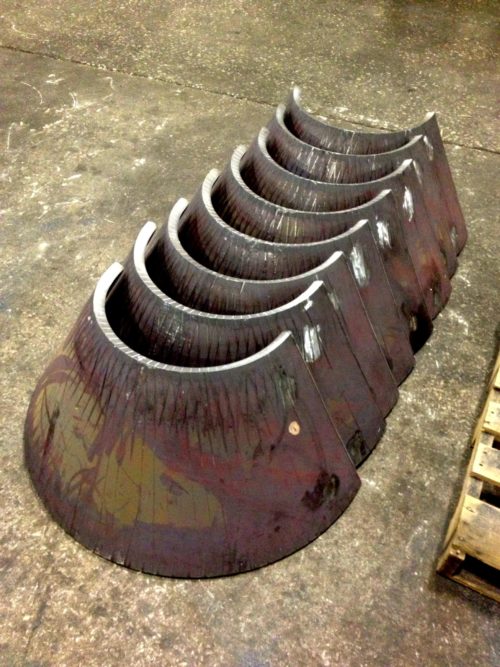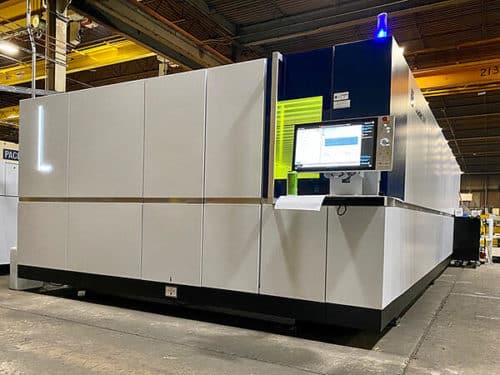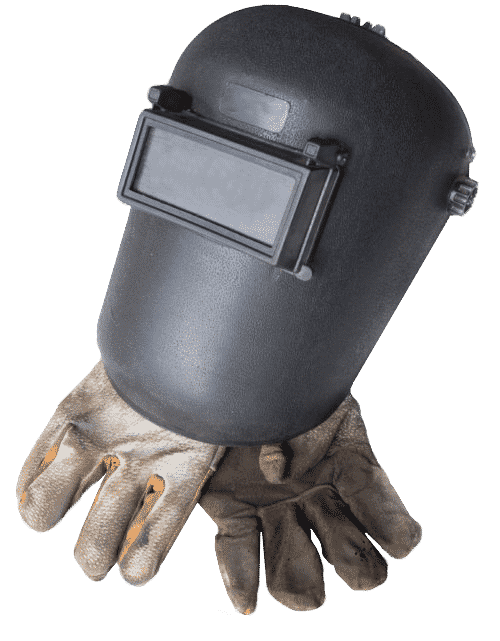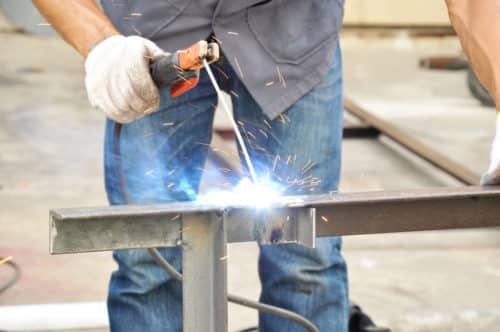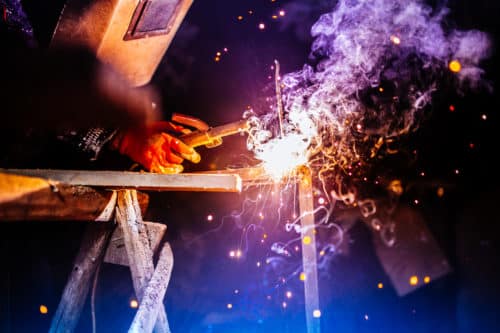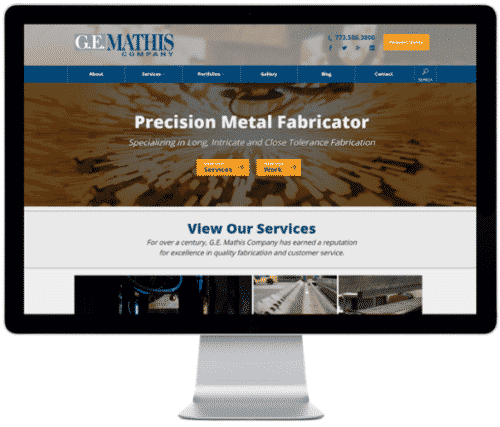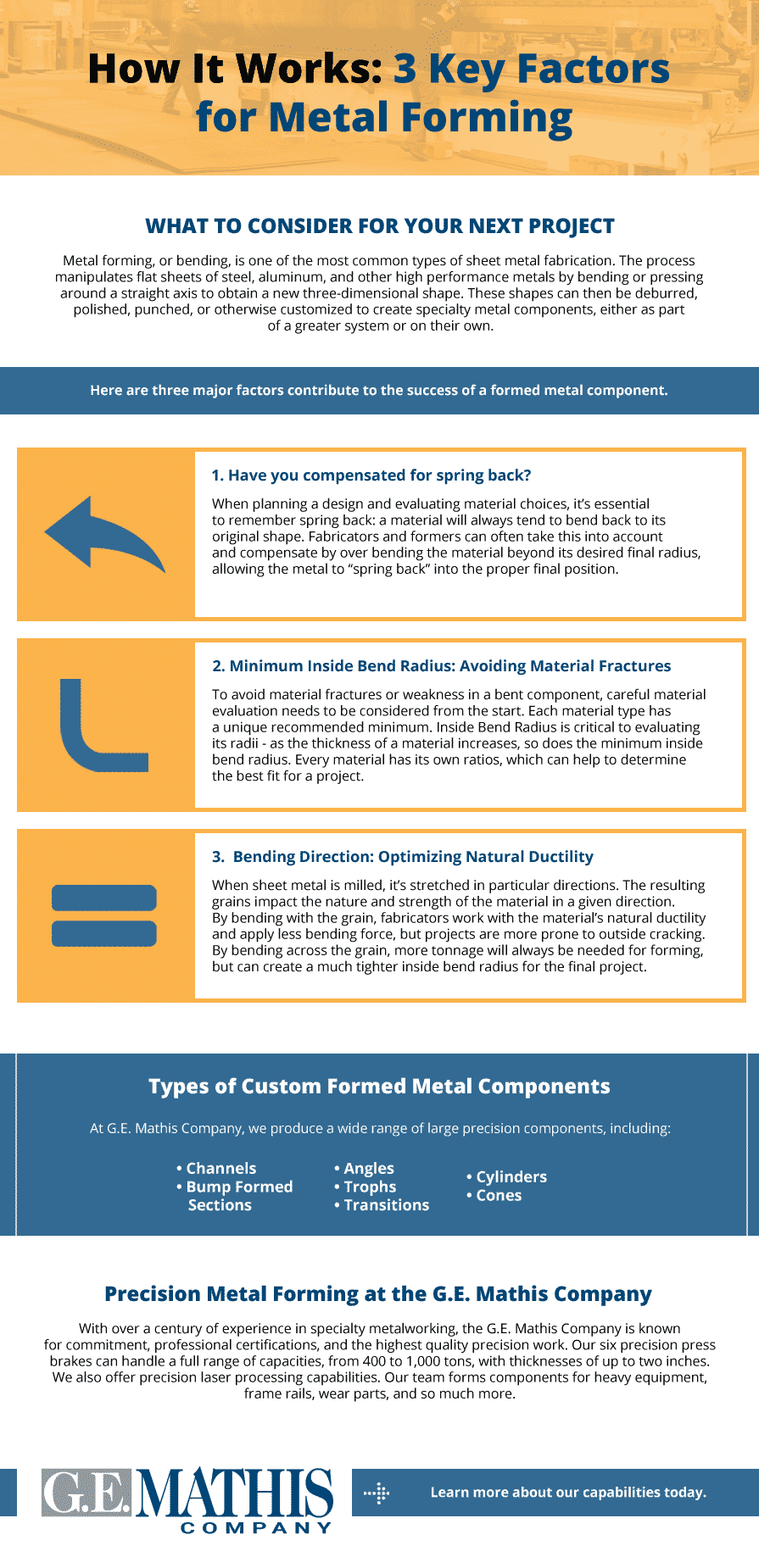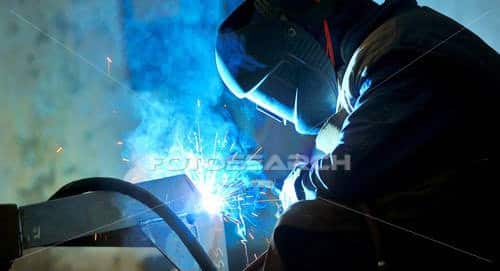All About Metal Fabrication
Metal fabrication refers to the process of cutting, shaping, or molding raw or semi-raw metal materials into an end product. Depending upon the type and grade of metal, as well as the desired end product, metal fabricators may employ a variety of techniques to manufacture cost-effective, high-quality components for a wide range of industrial applications.
Types of Metal Fabrication Processes
Some of the different metalworking methods metal fabricators employ include:
Cutting
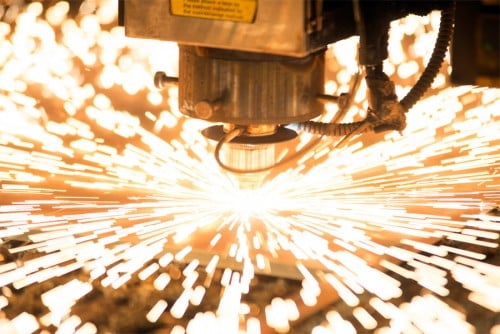
- Sawing is the oldest method of producing straight cuts through metal materials.
- Laser cutting employs a high-powered, focused laser beam of light to cut through the metal materials.
- Waterjet cutting operations utilize a high-powered water stream to cut through different materials, including metal.
- Plasma Cutting uses a mixture of swirling gases to cut through metal.
- Shearing uses two large blades to cut through metal like a giant pair of scissors.
- CNC cutting uses a computer-controlled machine to make precise cuts through metal via a variety of metal cutting techniques (e.g., laser cutting, plasma cutting, etc.)
- Die cutting employs steel rule (flatbed die cutting) or cylindrical (rotary die cutting) dies to cut out precise metal shapes.
Forming/Bending
Unlike cutting, forming (or bending) doesn’t remove material from the metal work-piece. Instead, the process alters the work-piece with a machine such as a press brake, or by a hand-held method such as with a hammer, or die to fit the required specifications.
Welding
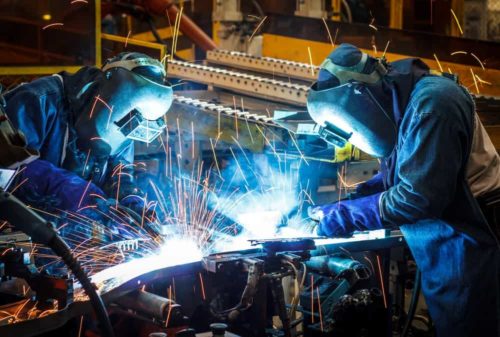
- Submerged arc welding (SAW): This welding method employs a continuous electrode to create an arc between the welding rod and the work-piece. The addition of a thick granular flux forms a shield that protects the weld zone from atmospheric contamination during operations.
- Shielded metal arc welding (SMAW): This welding method—also referred to as stick welding—uses a welding rod coated in flux that carriers a high-power electrical current. The coating breaks down during welding operations, forming a layer of slag and a gas shield that protects the weld as it cools.
- Gas metal arc welding (GMAW): This welding method—also known as MIG welding—relies on an adjustable and continuous solid wire electrode. During operations, the electric arc formed between the work-piece and the electrode heats and melts the base metals to form the weld.
- Gas tungsten arc welding (GTAW): This welding method—also called TIG welding—requires the use of a non-consumable tungsten electrode. It produces strong welds without fillers.
- Fluxed core arc welding (FCAW): This welding method is similar to GMAW welding, except it utilizes a tubular wire electrode filled with flux rather than a solid wire electrode. Self-shielded FCAW operations rely only on flux to protect the weld zone, while dual-shielded FCAW operations rely on both flux and an external shielding gas.
Stamping
Uses a top and bottom die molded into a custom 3-dimensional shape. When the metal is pressed between the two dies, it conforms to the desired shape. This process is used to make many complex metal shapes, such as body panels for the automotive industry.
Machining
Uses CNC-controlled machinery with various cutting tools to rapidly produce a custom 3-dimensional metal component by removing unwanted materials.
Advantages and Applications of Metal Fabrication Processes
There are several different types of metal fabrication processes employed by industry professionals to produce metal parts and products. As each process utilizes different techniques and equipment, it offers distinct advantages and best use cases.
Advantages and Applications of Cutting
Perhaps the most ubiquitous of all metal fabrication processes, cutting can be employed alongside other methods. In general, cutting offers several advantages with more modern techniques providing enhanced manufacturing capabilities. Some of the advantages of using cutting to fabricate metal parts include:
- Greater precision
- Higher repeatability
- Faster production speeds
- Better cost-effectiveness
Advantages and Applications of Forming/Bending
Metal fabricators use forming operations—e.g., rolling, indenting, and bending—to produce many metal parts, such as pipes, enclosures, and boxes. The advantages of using these operations include:
- Broader product capabilities
- Greater part design flexibility, including for complex shapes and geometries
Advantages and Applications of Welding
In general, welding allows for minimal waste production, reduced labor and material costs, and process portability. Each of the individual welding techniques also offers unique benefits. For example:
TIG Welding Benefits
Commonly used for aluminum and aluminum alloys, TIG welding produces a better surface finish than MIG welding and doesn’t require a filler material to produce the weld.
MIG Welding Benefits
Commonly used on steel, MIG welding does require the use of consumable filler material (i.e., the feeding wire). However, compared to TIG welding, it is faster and easier to control.
Sticking Welding Benefits
Commonly used on iron and steel, stick welding is the simplest welding technique. As such, it is used extensively for industrial fabrication applications.
Advantages and Applications of Stamping
Stamped parts are found across a diverse set of industries. The stamping process allows for:
- Higher precision and accuracy
- Faster production speeds
- Lower per-unit production costs (for high-volume runs)
Advantages and Applications of Machining
Machining is a broad industrial term for subtractive manufacturing processes, such as drilling, milling, and turning. While some companies still rely on manual machining units, many companies have adopted the use of computer numerical control (CNC) machining equipment. The latter enables industry professionals to achieve the following:
- Tighter tolerances
- Higher production consistency
- Greater cost-efficiency (for small to medium runs)
Metal Fabrication Solutions From G.E. Mathis Company
At G.E. Mathis Company, we offer industry-leading metal fabrication services to customers across a diverse set of industries. Equipped with a 135,000 square foot, state-of-the-art manufacturing facility and over a century of industry experience, our team provides:
Precision Laser Processing
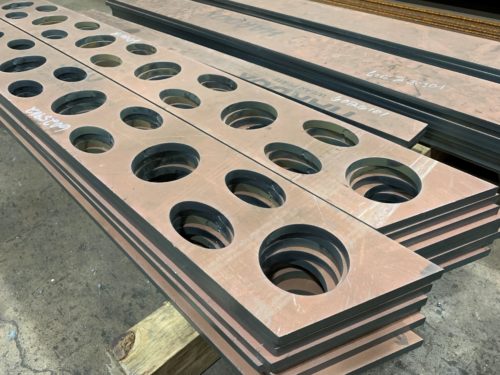
Precision CNC Plasma Cutting
We utilize 4-axis machines capable of high-definition cutting action to provide precision CNC plasma cutting services. The equipment’s 400 amp, straight, dual-head, and contour beveling capabilities help us provide superior results across a wide variety of materials, including carbon, aluminum, stainless steel, and exotic metals.
Precision Forming/Bending
For our precision forming/bending operations, our team utilizes eight hydraulic press brakes, including two equipped with CNC capabilities. These machines feature 400- to 1,000-ton capacities and accommodate thicknesses up to 2 inches and lengths of 20, 20, 30, 23, 25, 40, and 48 feet.
Some of the formed/bent components we fabricate include:
- Cones
- Cylinders
- Ob-rounds
- Segments
- Channels and angles
- Bump formed sections
We process a variety of materials in these operations, such as:
- Carbon steel
- Stainless steel
- Aluminum
- Brass
- Bronze
- Copper
- Titanium
- Hardox® wear plate
Precision Welding
Our AWS-certified welders are capable of providing precision arc and MIG welding services using CNC-controlled welding and fully automated processes, including:
- Dual-wire submerged arc welding
- Flux cored arc welding—i.e., FCAW
- Gas metal arc welding—i.e., GMAW
- Gas tungsten arc welding—i.e., GTAW
- Shielded metal arc welding—i.e., SMAW
- Submerged arc welding—i.e., SAW
We weld materials up to 12 feet wide and 50 feet long, including:
- Carbon steel
- Stainless steel
- Aluminum
- Hardox® wear plate
HARDOX® Wearparts Fabrication
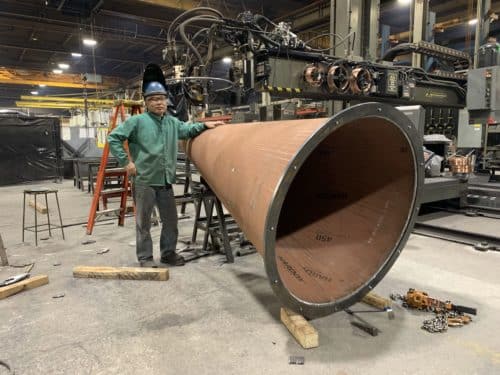
- HARDOX 450
- HARDOX 500
- STRENX 100 (Domex® 100)
- STRENX 110 (Domex® 110)
- STRENX 700
- WELDOX 100
- WELDOX 110
These products are available in up to 2-inch thicknesses with industry-leading tolerances to meet even the most demanding application requirements.
In addition to being an ISO 9001:2015-certified manufacturer, G.E. Mathis Company can provide the following services:
- PPAP (Production Part Approval Process) – All Levels
- FAIR (First Article Inspection Report)
- Capability Studies (Statistical Process Control)
- CMRT (Conflict Minerals Reporting Template)
At G.E. Mathis Company, we have over a century of experience providing metal fabrication solutions. If you have a metal fabrication project, we can meet your needs. Contact us today for more information about our metal fabrication capabilities or request a quote from one of our experts for your next project.
Announcing the Addition of the 8-kW Fiber Optic Laser Cutting System
As an industry leader in the fabrication of long, close-tolerance components, G.E. Mathis Company is committed to continuously expanding its service offerings. Most recently, we’ve added an 8-kilowatt fiber-optic laser cutting system—one of the largest pallet-changing laser formats in the industry—to our facility. This new addition allows us to increase the efficiency of our processing operations for materials as large as 100 inches wide by 240 inches long as well as offers several other improvements to our laser processing capabilities.
Features and Capabilities of the 8kW Fiber Optic Laser Cutting System
The integration of the new 8kW laser into our facility has greatly increased and improved our laser processing capabilities. Employing a 3-axis flying optic (or hybrid) positioning system, LoadMaster automatic sheet loading system, and BrightLine Fiber adaptive laser beam in a full enclosure, it accommodates the following project specifications:
- Manufacturing type: prototype, contract manufacturing, and fabrication
- Materials: carbon steel, stainless steel, abrasion-resistant (AR) steel such as HARDOX®, high-strength steel such as STRENX®, aluminum, and other alloys.
- Material thicknesses: up to 1.25 inches for carbon steel and up to 1 inch for stainless steel
- Tolerances: starting at +/- .015 inches
- Volume: Prototype to production
- Delivery/lead time: 1 to 2 weeks
- Industry standards: 1SO 9001:2015
- File formats: AutoCad, Inventor, PDF, DWG, DXF, STEP
Benefits of the 8-kW Fiber Optic Laser Cutting System
Using the new system for our laser processing operations provides us with a number of benefits, including:
- Broader material capabilities. The laser system allows us to cut a variety of steel and steel alloys in greater thicknesses (up to 1 inch for stainless and 1.25 inch for carbon).
- Higher cut quality. The system’s BrightLine Fiber adaptive beam mode facilitates the production of higher quality cuts in even thick plates, simplifies the removal of individual parts, and reduces the contours created throughout cutting operations.
- Safer and more environmentally sound operations. As the system’s critical components are fully contained within an enclosure, laser processing operations that employ it offer a lower risk to personnel and the surrounding environment.
Industries Served by the 8kW Fiber Optic Laser Cutting System
Equipped with the new system, we are able to provide more advanced laser processing services to the following industries:
- Aerospace
- Agricultural
- Contract manufacturing
- High-quality component manufacturing
- Military
- Construction
- Mining
Laser Processing Solutions From G.E. Mathis Company
At G.E. Mathis Company, we are dedicated to providing high-quality laser processing solutions to our customers. Craig Mathis—President of G.E. Mathis Company—best states how we go about achieving this goal: “We continue to invest in the latest fabrication technology which enables us to deliver value-added products to the industries we serve.” Our current processing equipment includes three different types of lasers (including the 8kW fiber optic laser) and large-capacity gantry-type and pallet-type processing systems, which allow us to cut a wide range of designs and geometries in materials ranging from 16 gauge sheet to 1.25 inch thick plate.
In addition to being an ISO 9001:2015-certified manufacturer, G.E. Mathis Company can provide the following services:
- PPAP (Production Part Approval Process) – All Levels
- FAIR (First Article Inspection Report)
- Capability Studies (Statistical Process Control)
- CMRT (Conflict Minerals Reporting Template)
In addition to our top-of-the-line laser processing services, we also offer secondary and finishing services. As a one-stop shop, we provide faster turnaround and reduced manufacturing costs. For more information on our laser cutting equipment and services, contact us today.
Understanding Different Types of Welding
An extremely versatile fabrication process, welding is used in nearly every industry, from agriculture and mining to construction and aerospace. Over the years, specialized welding techniques have been developed to better suit the needs of specific industry challenges, whether they involve fusing dissimilar metals or custom fabricating parts for critical-use applications.
To determine which type of welding is best suited for a specific project, welders must consider the physical properties of the workpiece and filler material, desired product specifications, necessary equipment and power supplies, and the customer’s timeframe.
Let’s look at some of today’s most widely used welding methods and how they differ:
Types of Welding
Submerged Arc Welding
Requiring a continuous electrode feed to create an arc between a welding rod and the workpiece, this type of welding adds a thick granular flux to form a shield. The result is a flux blanket, under which the arc is submerged to protect the weld zone from atmospheric contamination. This process can be automated, mechanized, or semi-automated through the use of hand-held guns.
Shielded Metal Arc Welding (SMAW)
Commonly referred to as “stick” welding, shielded metal arc welding (SMAW) is an inexpensive, manual process requiring a welding rod coated in flux, which carries a high-power electric current. During welding, the electrode’s flux coating breaks down, creating a layer of slag as well as a gas shield to protect the weld until it cools. Final products may require finishing services, however, as molten splatter is a common occurrence.
Gas Metal Arc Welding (GMAW)
Gas metal arc welding, also called MIG (metal inert gas) welding, is distinct in its use of an adjustable, continuous solid wire electrode feed. Versatile and easily automated, GMAW only requires that the welder guides the welding gun in the proper position and orientation along the fusion point. The electric arc formed between the electrode and the workpiece heats and melts the metals to join them.
Flux Core Arc Welding (FCAW)
Similar to MIG welding, flux core arc welding uses a tubular wire filled with flux in place of a solid wire. Dual-shielded FCAW uses the flux with an external shielding gas for protection, while self-shielded FCAW relies only on flux to protect the molten weld puddle, making this an ideal option for outdoor applications. As an automated process, FCAW is also popular for projects requiring quick turnaround times.
Gas Tungsten Arc Welding (GTAW)
Gas tungsten arc welding, more commonly referred to as TIG (tungsten inert gas) welding, uses a non-consumable tungsten welding rod (or electrode) to apply intense heat to the base metal. This produces an autogenous weld by melting two pieces of metal directly together without a filler. TIG welds are also protected by an external shielding gas — usually argon. This method produces strong, high-quality welds, though the process can be painstaking, requiring extreme focus and precision to weld the small space between the arc and the workpiece.
Specialty Welding at G.E. Mathis Company
At G.E. Mathis Company, our experienced, skilled team of sheet metal welders is certified to AWS D1.1, D1.6, D9.1, and D10.9 standards. We work regularly with carbon steel, stainless steel, and HARDOX® Wearplate.
In addition to being an ISO 9001:2015-certified manufacturer, G.E. Mathis Company can provide the following services:
- PPAP (Production Part Approval Process) – All Levels
- FAIR (First Article Inspection Report)
- Capability Studies (Statistical Process Control)
- CMRT (Conflict Minerals Reporting Template)
To learn more about specialty welding, or to discuss how our team of experts can help with your next project, contact us today.
New Website for G.E. Mathis Company
G.E. Mathis Company recently launched a new website. This new site is completely redesigned from top to bottom. In addition to easier access and a totally new design, what else can you expect when you visit G.E. Mathis Company’s brand new website?
Here’s an overview of the latest updates:
1. Improved accessibility
Our new drop-down navigation menu makes it easier to browse our valuable resources and company information. The navigation menu is conveniently located at the top of each page. Users can easily access our services, industries, case studies, photo gallery, and more.
2. More user-friendly experience
With over a century’s worth of experience, we at G.E. Mathis Company pride ourselves on delivering quality services and capabilities to our customers. With that in mind, we’ve ensured that our new website offers the best possible user experience. We’ve achieved this goal by implementing a completely new and more appealing design. We have also given the site a responsive design. This makes it simple to access our site on any desktop, tablet or mobile device.
3. Enhanced information
We know when users visit a website, they want to find relevant information quickly and easily. Our new website highlights past projects we’ve successfully completed by showcasing them in our portfolios. These feature jobs in laser cutting, forming, plasma cutting, and welding. We also provide the most up-to-date information on all of the services we offer, including:
- Laser Processing
- High-Def CNC Plasma Cutting
- Precision Forming/Bending
- Welding
- HARDOX® Wearparts Fabrication
In addition to being an ISO 9001:2015-certified manufacturer, G.E. Mathis Company can provide the following services:
- PPAP (Production Part Approval Process) – All Levels
- FAIR (First Article Inspection Report)
- Capability Studies (Statistical Process Control)
- CMRT (Conflict Minerals Reporting Template)
We encourage you to browse our new website today to learn more about the intricate and close-tolerance fabrication services we provide. These cover a vast range of industries from construction, agricultural, chemical, defense, mining, trailers/truck bodies, contract manufacturing, and much more. You can also always request a quote, or contact us with any questions or learn how we can assist you with your next project.
How It Works: 3 Key Factors for Metal Forming
What to Consider for Your Next Project
Metal forming, or bending, is one of the most common types of metal fabrication. The process manipulates flat sheets of steel, aluminum, and other high performance metals by bending or pressing around a straight axis to obtain a new three-dimensional shape. These shapes can then be deburred, polished, or otherwise customized to create specialty metal components, either as part of a greater system or on their own.
Here are three major factors contribute to the success of a formed metal component.
1. Have you compensated for spring back?
When planning a design and evaluating material choices, it’s essential to remember spring back: a material will always tend to bend back to its original shape. Fabricators can often take this into account and compensate by over bending the material beyond its desired final radius, allowing the metal to “spring back” into the proper final position.
2. Minimum Inside Bend Radius: Avoiding Material Fractures
To avoid material fractures or weakness in a bent component, careful material evaluation needs to be considered from the start. Each material type has a unique recommended minimum. Inside Bend Radius is critical to evaluating its radii — as the thickness of a material increases, so does the minimum inside bend radius. Every material has its own ratios, which can help to determine the best fit for a project.
3. Bending Direction: Optimizing Natural Ductility
When sheet metal is milled, it’s stretched in particular directions. The resulting grains impact the nature and strength of the material in a given direction, so be sure to note whether a sheet is being formed with (longitudinally) or across the grain.
By bending with the grain, fabricators work with the material’s natural ductility and apply less bending force, but projects are more prone to outside cracking. By bending across the grain, more tonnage will always be needed for forming, but can create a much tighter inside bend radius for the final project.
Types of Custom Formed Metal Components
Metal forming specialists craft the critical components needed to support almost every industry — aerospace, military, automotive, medical, food service, manufacturing, communications — the list goes on and on. At G.E. Mathis Company, we produce a wide range of large precision components, including:
- Channels
- Angles
- Formed Pan sections
- Transition segments
- Bump Formed Sections
- Cones
Precision Metal Forming at the G.E. Mathis Company
With over a century of experience in specialty metalworking, the G.E. Mathis Company is known for commitment, professional certifications, and the highest quality precision work. Our eight precision press brakes can handle a full range of capacities, from 400 to 1,000 tons, with thicknesses of up to two inches. We offer metal fabrication beyond bending and forming, too — precision laser processing, plasma cutting, and welding are a few of our capabilities.
Our team forms components for heavy equipment, frame rails, wear parts, and so much more. Contact us to discuss your next project with one of our metal forming professionals or learn more about our capabilities today.
Welding Capabilities for the Construction Industry
Welding is instrumental to the success of a construction project. Not only is it a handy repair tool for broken and damaged machine parts, it is the mainstay of production supplying any construction endeavor with the required raw materials to progress at the desired pace.
It is undertaken by skilled operators and has to be performed according to pre-defined mandates and a set of compliance rules in order to ensure that the joints are strong and immune to jostling and rust.
WELDING, ITS IMPORTANCE AND IMPERATIVE IN CONSTRUCTION
All kinds of welding rely on generating an arc that is capable of raising the temperature of the parent material to the melting point. It is then fused with a filler metal which by rule of thumb is chosen to be structurally
stronger than the original base. Ranging from sub-merged arc to metal active gas to manual metal arc, different welding processes are leveraged at construction sites around the world to serve unique needs. Special ventures in the aerospace and naval industries have progressed to laser arc hybrid welding and electron beam technology.
An operation team manipulating welding equipment must be knowledgeable of the nuances of this technique in order to ensure the integrity of welded joints and thus by association created products. A large scale construction project is only as durable as the quality of its individual components.
Also according to the Consumer Justice Group report, welding tasked to untrained labor is an extremely hazardous proposition. Thousands of injuries occur right on-site because of careless handling of equipment or experimentation by unskilled staff.
SOME BEST PRACTICES TO KEEP IN MIND
As far as possible, complicated welding responsibilities must be left to professionals. Construction projects call for the employment of AWS (American Welding Society) certified welders who are cognizant of the involved risks and capable of handling them expertly.
Especially for the frequently used MIG (Metal Inert Gas) welding:
- Care should be taken to ensure that welders wear protective gear (including an auto-darkening face shield) to eliminate the riskofcontact burns and blisters
- Cotton is the chosen material because it doesn’t melt like polyester
- Be on the look-out for splatters of molten metal and grinding sparks which can cause a fire
- Avoid using galvanized steel as the parent material since it gives off carcinogenic vapors
G.E. MATHIS COMPANY AND ITS HISTORY OF EXCELLENCE:
G.E. Mathis Company has been an industry renowned name in the field of precision arc and MIG welding. We have perfected our craft over 100 years of rigorous practice assisting construction companies, OEMs, independent projects and manufacturers with their welding and rolling needs. ISO 9001:2015 certified, we are the gold standard in the welding and precision services domain.
Feel free to request a quote, or contact us today at 773.586.3800 and we will be glad to discuss how our fabrication and welding capabilities may help with your next project
American Manufacturing in 2014 and the Outlook for 2015
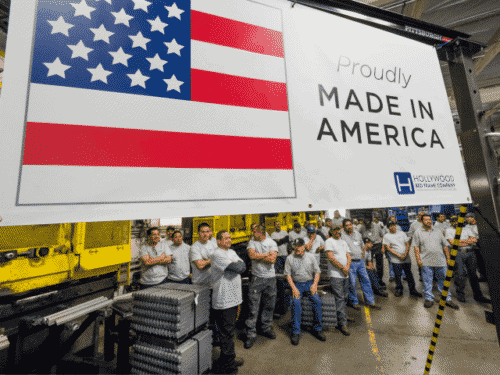
Pundits are attributing this ‘revival’ of US manufacturing to three main reasons:
- Because of the sophistication of the fracking process, the US is now the largest producer of oil and natural gas in the world, trumping Saudi Arabia to claim the elusive title. The implications of this feat are profound leading to a significant drop in transportation as well as electric costs within the country.
- Because of the innovations in the field of robotics, the rote work of wrench turning has now been delegated to industrial robots and other precision instruments. The main issue with labor in the US was availability of reliable and competent blue collar workers for the minimum wage rate. Thanks to the automation of certain processes, human ingenuity and logic can be better rewarded with higher paying jobs of supervisors and managers.
- United States can now boast very low cost of raw materials leading to a dip in overall manufacturing investment as well.
The US manufacturing sector alone is the 8th largest economy in the world, and this trend is likely to sustain in 2015 and even beyond.
The main focus of the coming years is going to be the Re-shoring vs. Offshoring battle. The global labor pool has become more aware of its rights, and the cry of improved wages is resonating from all corners of the world. Pay has risen by a significant 10% in China and were likely to spread to other countries as well.
Most probably the industries which are not labor intensive and suffer from the often prohibitive costs of long transportation routes (like chemicals and metals) will move back to home soil in order to take advantage of the boom in oil production and the easily available rich reserves of raw materials.
Ventures with high foreign demand and the pressing need for a lot of affordable labor to keep production running will continue to go the offshore way, especially if the manufacturing skill gap is not remedied.
The future of US Manufacturing is bright! But only time can shed light on the dominant trends which will re-shape the sector for the coming decades.
Our Metal Forming Skills are a Work of Art
Throughout the manufacturing industry, there has been a lot of discussion around what is known as the “skills gap.” The skills gap –essentially the lack of workers with appropriate skills for the industry—is becoming more of a problem as the baby boomer generation is beginning to retire and the younger workforce are finding careers in other fields. Not only is the skills gap affecting the bottom line, but’s it’s also providing manufacturers with a major challenge.[1]
Here at G.E. Mathis Company, we understand the importance of these technical skills, as they allow our craftsmen to perform at the highest levels. Take, for example, our forming capabilities. Our advanced equipment and expertise allow us to process metal in a variety of dimensions and shapes, even up to 2” thick. Taking our forming services to the next level, we can bend long parts up to 48 ft. long.
Forming metal is an art, a skill acquired through observation and instruction. It is a skill that needs the human touch, one that cannot be completed by a robot or machine. Our skilled craftsmen pride themselves on their ability to form almost any shape. Some of the special shapes that we form, such as cone segments, cannot be processed through automation; instead, the operator needs to form the radiuses in the component using our unique equipment, working the metal blank to form the shape to the customer’s specifications. There is a complex process that we go through to form these complex parts.
This process requires a lot of technical skill, something that is becoming more and more unique, as we have seen due to the skills gap. However, our shop team continues to put this high level of skill into each part that they make, no matter what the customer’s specifications are. In fact, two recent projects we worked on exemplify the type of skill needed for metal forming: eccentric cones and elbow transitions.
Eccentric Cones
Unlike more traditional concentric cones, where the center points of each end of the cone are the same, the eccentric cones have these center points offset.
Elbow Transitions
Elbow transitions are used where a pipe needs to make a turn in an assembly. These also require a very specific and high level of skill to be able to fabricate and fit together with precision.
Neither of these projects had straight-forward dimensions, nor could they simply be made by an automated machine. Instead, they required specific radiuses that needed to be formed by a skillful hand. Rising to the challenge, our craftsmen have the skills to do so. G.E. Mathis Company will assure that these skills never become a lost art.
[1] http://www.sandiegonewsroom.com/business-finance/1282-how-to-combat-the-manufacturing-skills-gap
Making a Case for an American Manufacturing Resurgence
With over 110 years in the precision metal fabrication business, G.E. Mathis Company has seen plenty of ups and downs in the manufacturing sector. As the third annual National Manufacturing Day recently rolled around, we’d like to take a moment to look at the state of manufacturing in America.
It’s been well-documented that manufacturing was on the decline for a few decades across the nation. Outsourcing of jobs, companies on the move, and a developing skill gap were all seem as part of the problem. Another issue that arose was the decline of students interested in the science, technology, engineering, and mathematics (STEM) fields.

The rebound of manufacturing is being helped at many levels. For example, the U.S. government has taken part by funding various manufacturing hubs, known as “Manufacturing Innovation Institutes.” These hubs aim to focus on particular fields of manufacturing and technology and to attract a new generation of workers.[1]
While we don’t know if manufacturing will ever reach its high points of the past, there are good signs that manufacturing will rebound and settle in to a steady period of development and innovation, spurred on by a new generation of bright, hardworking, innovative individuals. G.E. Mathis Company will do its part to spur the American manufacturing renaissance, and we hope you will too.
Bridging the Way through Manufacturing’s Skills Gap
As a long-time American manufacturer, we have seen manufacturing rise and fall, as well as rapidly change due to up-and-coming technologies. Today, we certainly see how American manufacturing is experiencing a renaissance, due to re-shoring and new technology that has been introduced into the production process. However, there is one looming issue that is poised to greatly affect manufacturing’s success—that would be the skills gap.

Manufacturing companies throughout America are finding a variety of ways to rectify this issue. For example, there are some local schools that are trying to start STEM programs, giving young students a solid background in science, technology, engineering, and math fields. The City of Chicago is partnering with Chicago Public Schools and other organizations to offer an education focused on technology and sciences, ensuring that students are prepared for future careers in STEM fields.
While the skills gap is a problem for the manufacturing industry, educational organizations and many companies are working tirelessly to prepare young workers for our modern, technical, and challenging workforce. We encourage younger generations to realize the skills and opportunity that lie in a manufacturing career, and we hope to see you on the production floor soon!






